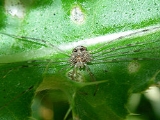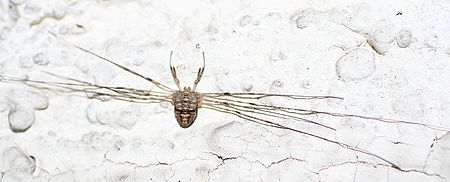
Dicranopalpus ramosus
Encyclopedia

Apophysis
Apophysis is an open source fractal flame editor and renderer for Microsoft Windows.Apophysis has many features for creating and editing fractal flames, including an editor which allows one to directly edit the transforms by manipulating triangles, a mutations window, which applies random edits to...
that reaches almost to the end of the tibia
Tibia
The tibia , shinbone, or shankbone is the larger and stronger of the two bones in the leg below the knee in vertebrates , and connects the knee with the ankle bones....
. This makes their pedipalp
Pedipalp
Pedipalps , are the second pair of appendages of the prosoma in the subphylum Chelicerata. They are traditionally thought to be homologous with mandibles in Crustacea and insects, although more recent studies Pedipalps (commonly shortened to palps or palpi), are the second pair of appendages of the...
s look forked. Their body is brownish with dark markings, the females being lighter colored.
The forked pedipalps and the resting posture, with the legs stretched to the sides, makes this species easy to identify, although the traditional method of collecting invertebrates does not prove adequate: of 103 individuals captured in Belgium, only one was found in a pitfall
Pitfall trap
A pitfall trap is a trapping pit for small animals, such as insects, amphibians and reptiles. Pitfall traps are mainly used for ecology studies and ecologic pest control. Animals that enter a pitfall trap are unable to escape, and may either be killed by the trap or remain unharmed...
; all others were collected by hand.
Adults can be found from August to November, mostly in gardens and on outer walls, but sometimes also inside.
Distribution
Originally the species was found in MoroccoMorocco
Morocco , officially the Kingdom of Morocco , is a country located in North Africa. It has a population of more than 32 million and an area of 710,850 km², and also primarily administers the disputed region of the Western Sahara...
. Later it spread into Europe, with first reports in Portugal (1948), where it spread to Spain
Spain
Spain , officially the Kingdom of Spain languages]] under the European Charter for Regional or Minority Languages. In each of these, Spain's official name is as follows:;;;;;;), is a country and member state of the European Union located in southwestern Europe on the Iberian Peninsula...
(1965) and France
France
The French Republic , The French Republic , The French Republic , (commonly known as France , is a unitary semi-presidential republic in Western Europe with several overseas territories and islands located on other continents and in the Indian, Pacific, and Atlantic oceans. Metropolitan France...
(1969). The Netherlands
Netherlands
The Netherlands is a constituent country of the Kingdom of the Netherlands, located mainly in North-West Europe and with several islands in the Caribbean. Mainland Netherlands borders the North Sea to the north and west, Belgium to the south, and Germany to the east, and shares maritime borders...
were reached in 1992. Since 2004 it is known to occur in Germany
Germany
Germany , officially the Federal Republic of Germany , is a federal parliamentary republic in Europe. The country consists of 16 states while the capital and largest city is Berlin. Germany covers an area of 357,021 km2 and has a largely temperate seasonal climate...
. As early as 1957, it was reported in Bournemouth
Bournemouth
Bournemouth is a large coastal resort town in the ceremonial county of Dorset, England. According to the 2001 Census the town has a population of 163,444, making it the largest settlement in Dorset. It is also the largest settlement between Southampton and Plymouth...
, southern England
England
England is a country that is part of the United Kingdom. It shares land borders with Scotland to the north and Wales to the west; the Irish Sea is to the north west, the Celtic Sea to the south west, with the North Sea to the east and the English Channel to the south separating it from continental...
, from where it spread all over the island, reaching Scotland
Scotland
Scotland is a country that is part of the United Kingdom. Occupying the northern third of the island of Great Britain, it shares a border with England to the south and is bounded by the North Sea to the east, the Atlantic Ocean to the north and west, and the North Channel and Irish Sea to the...
in 2000. In 2010, one occurrence in Denmark was documented.
The very similar and closely related D. gasteinensis is found in the Alps
Alps
The Alps is one of the great mountain range systems of Europe, stretching from Austria and Slovenia in the east through Italy, Switzerland, Liechtenstein and Germany to France in the west....
.
External links
- BioImages: D. ramosus

